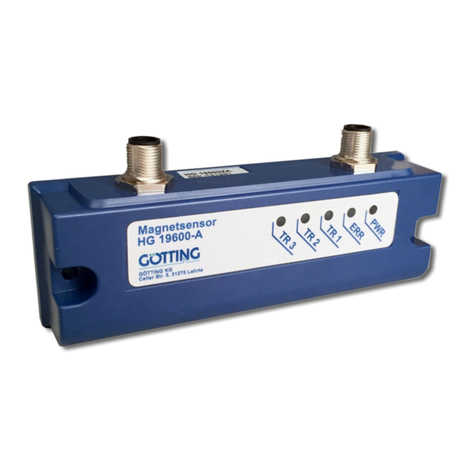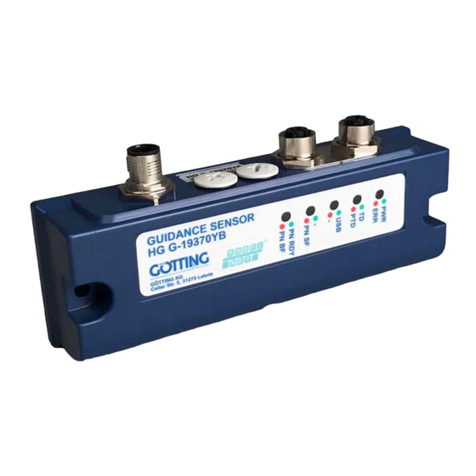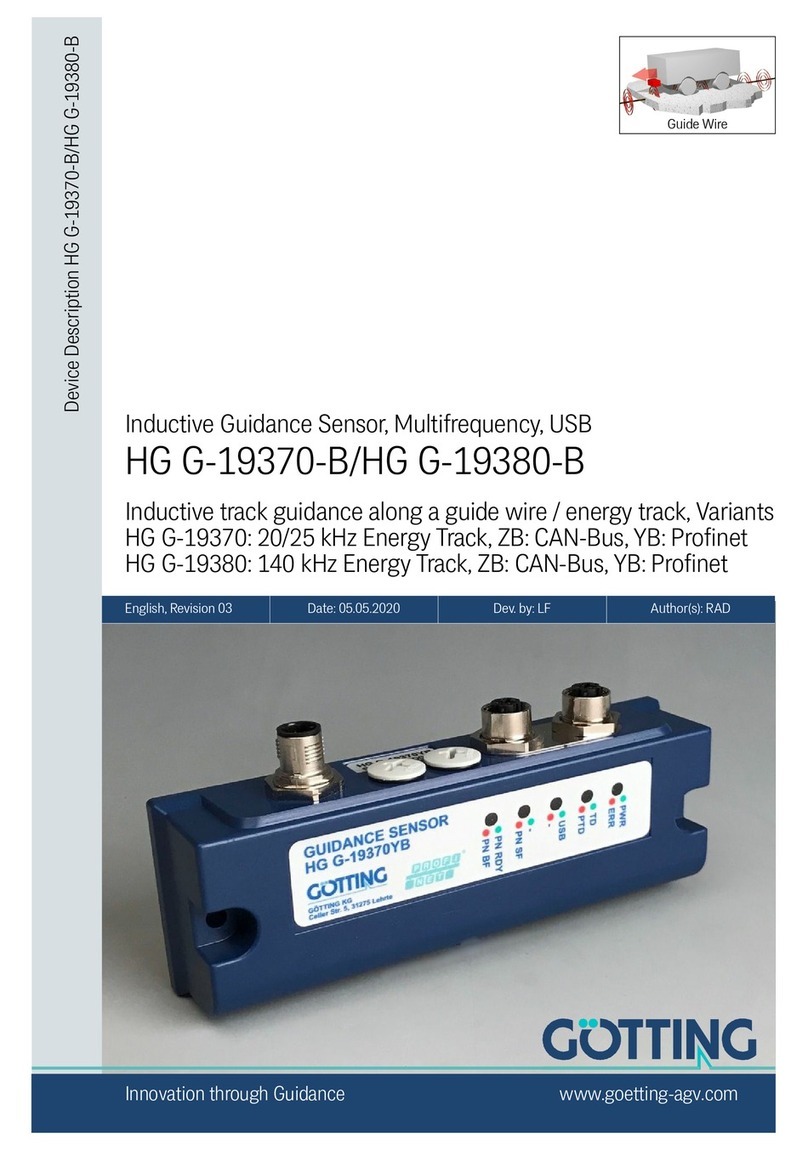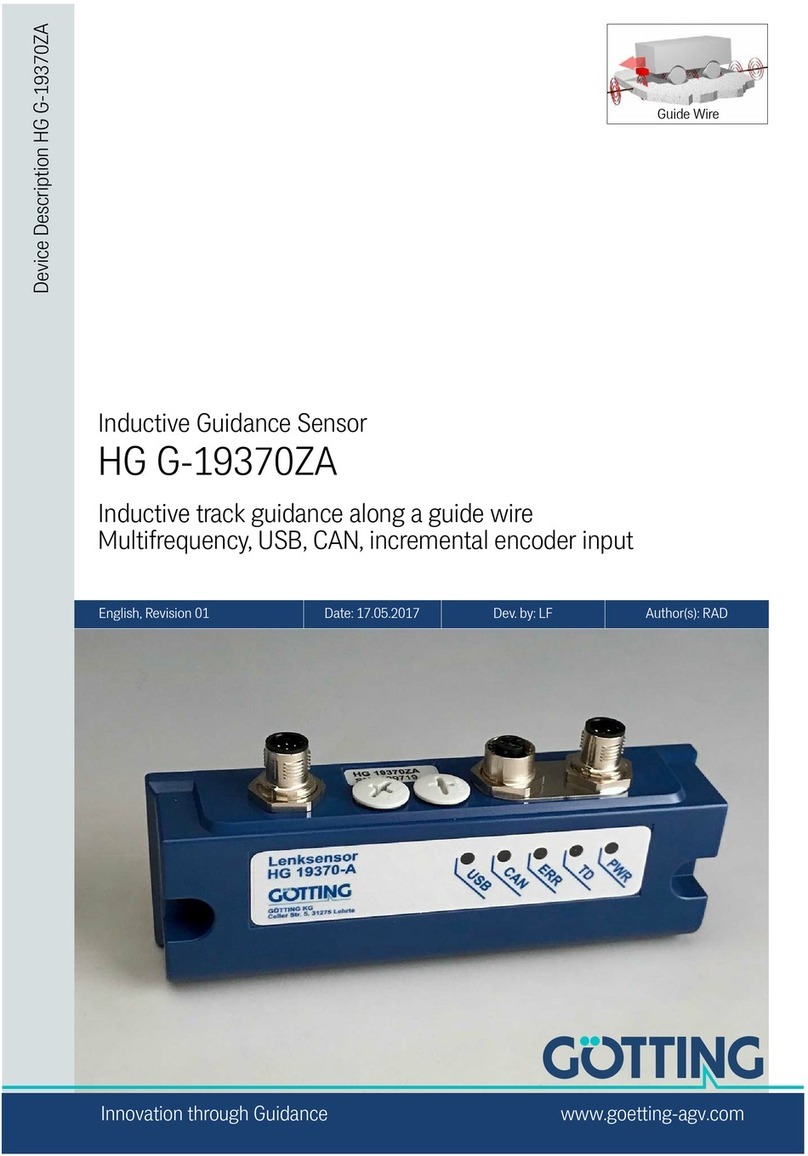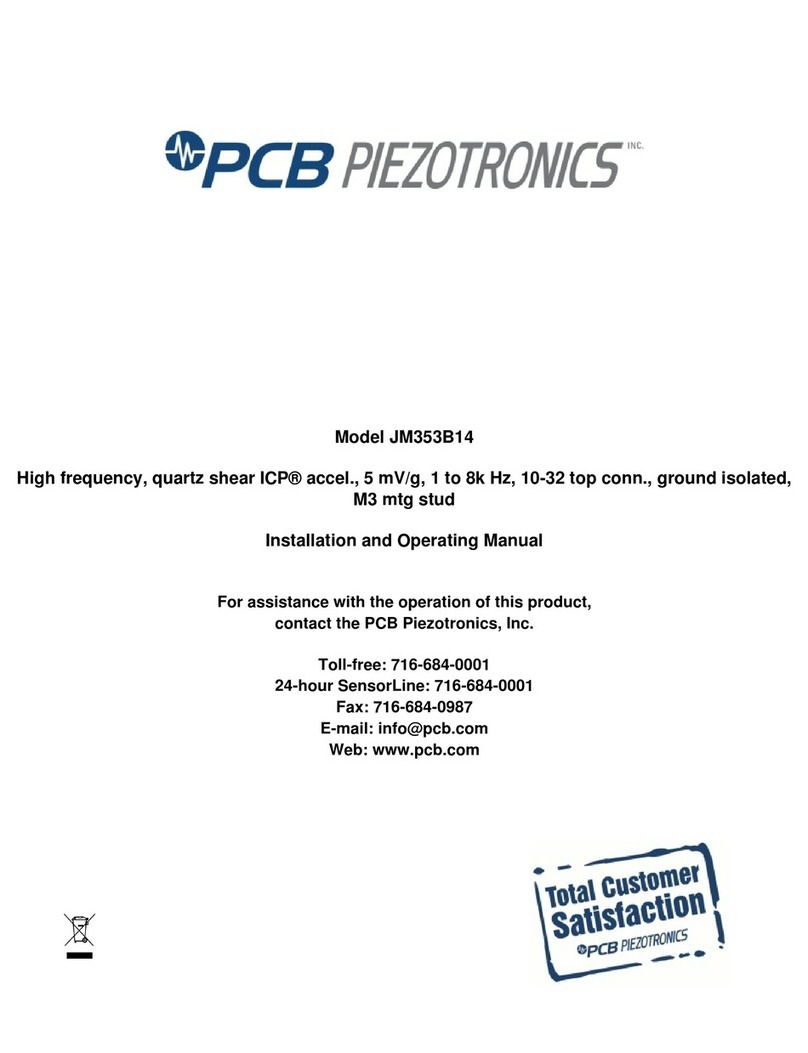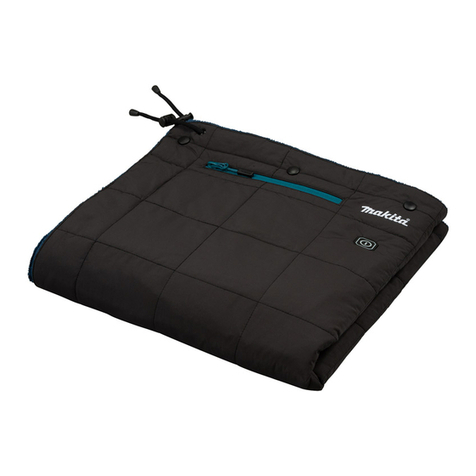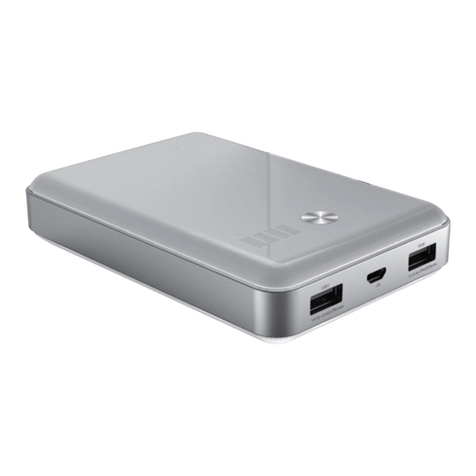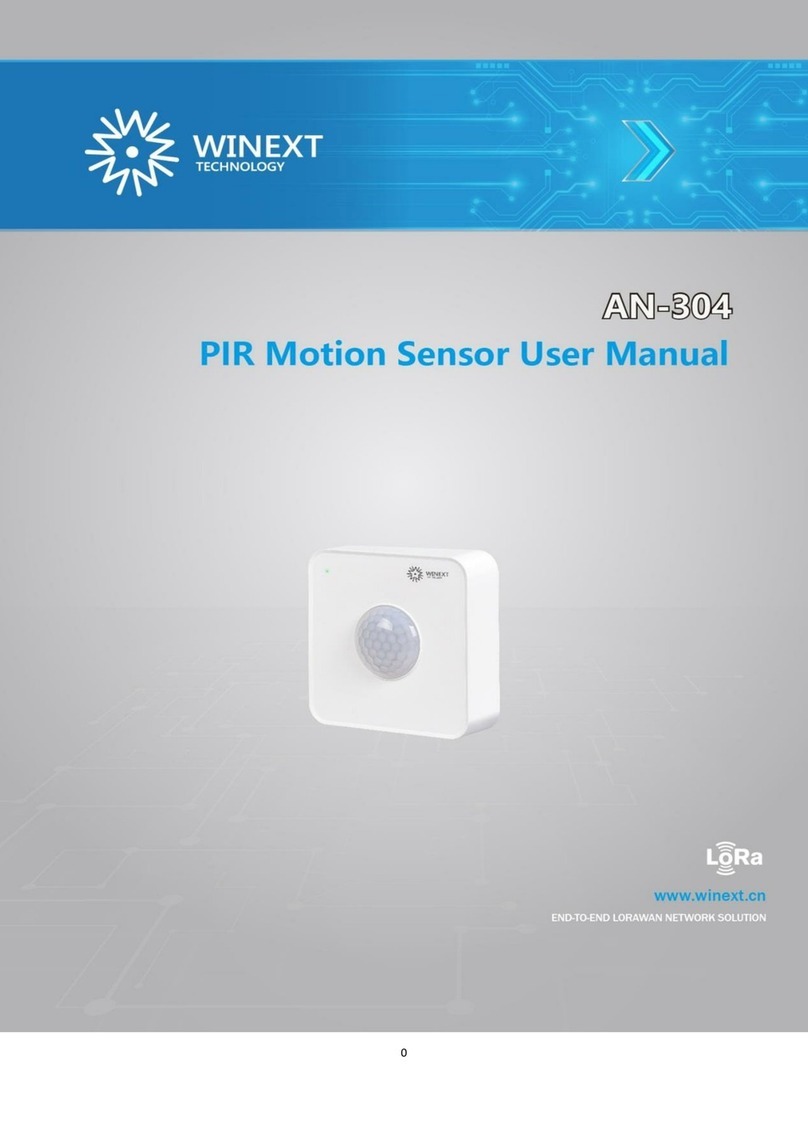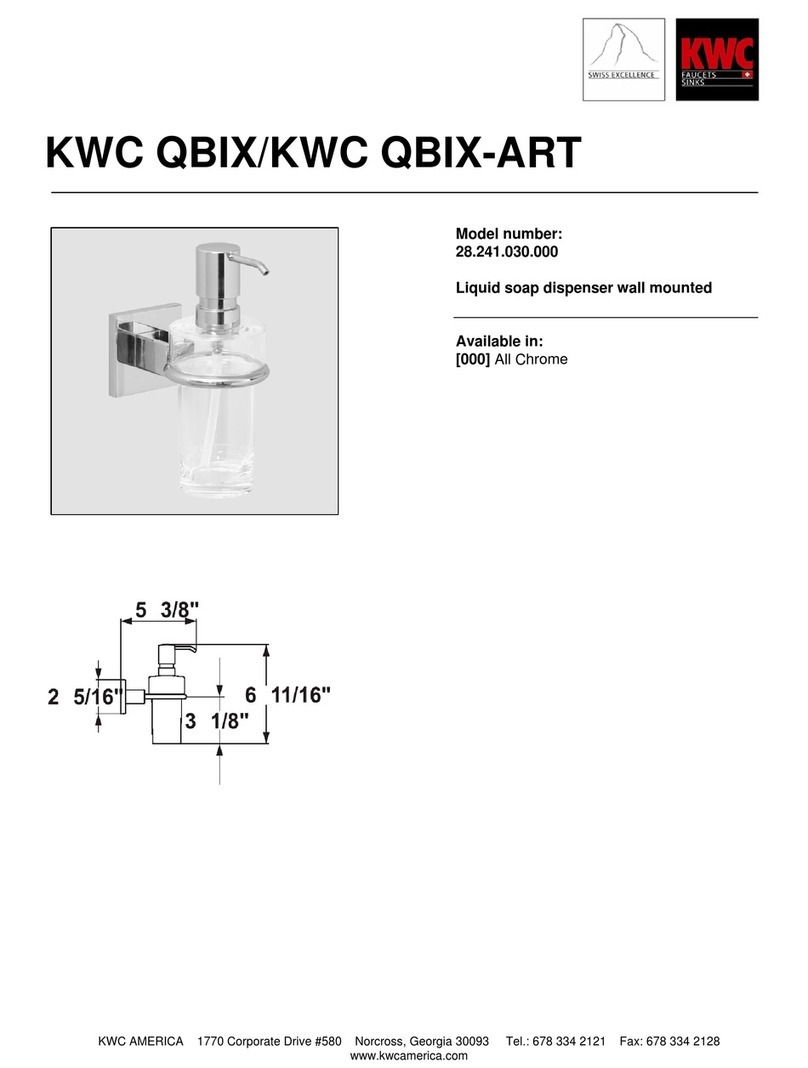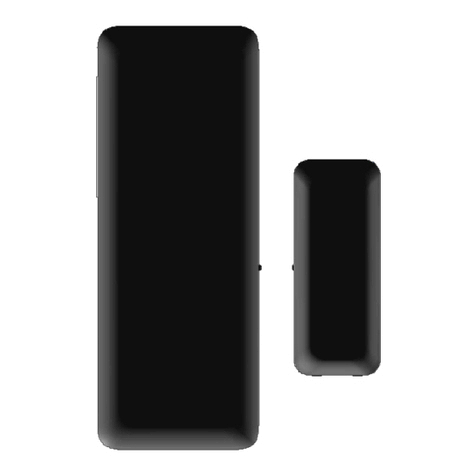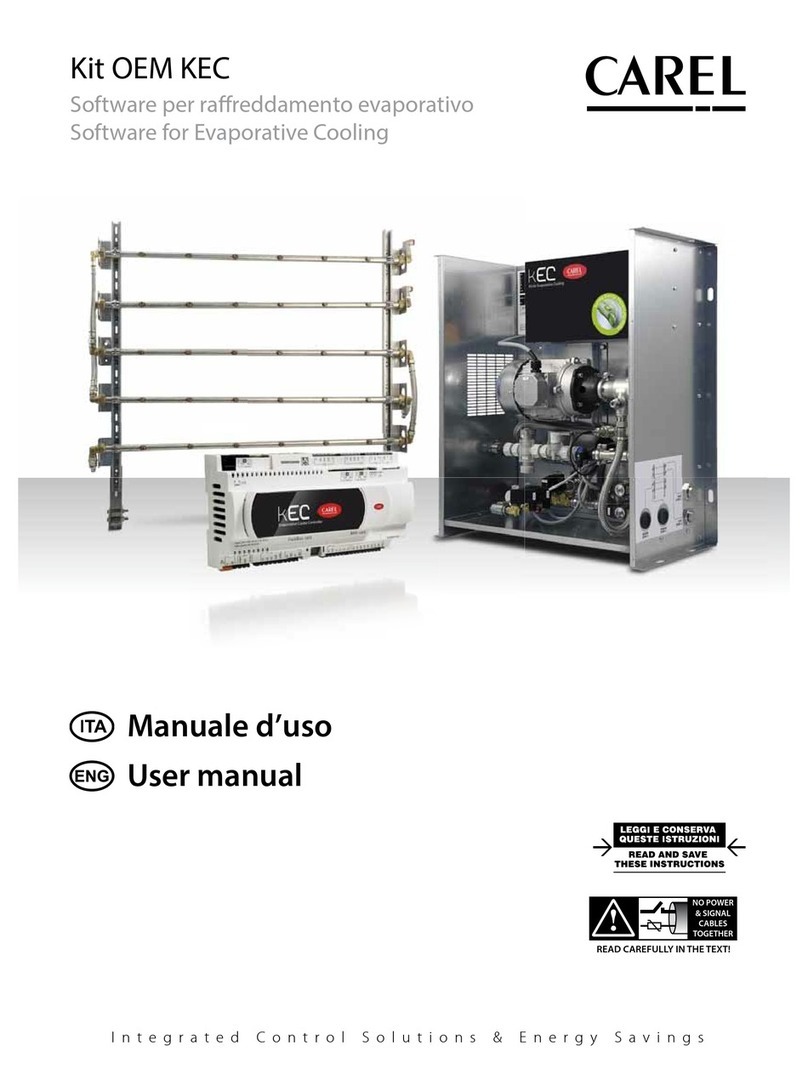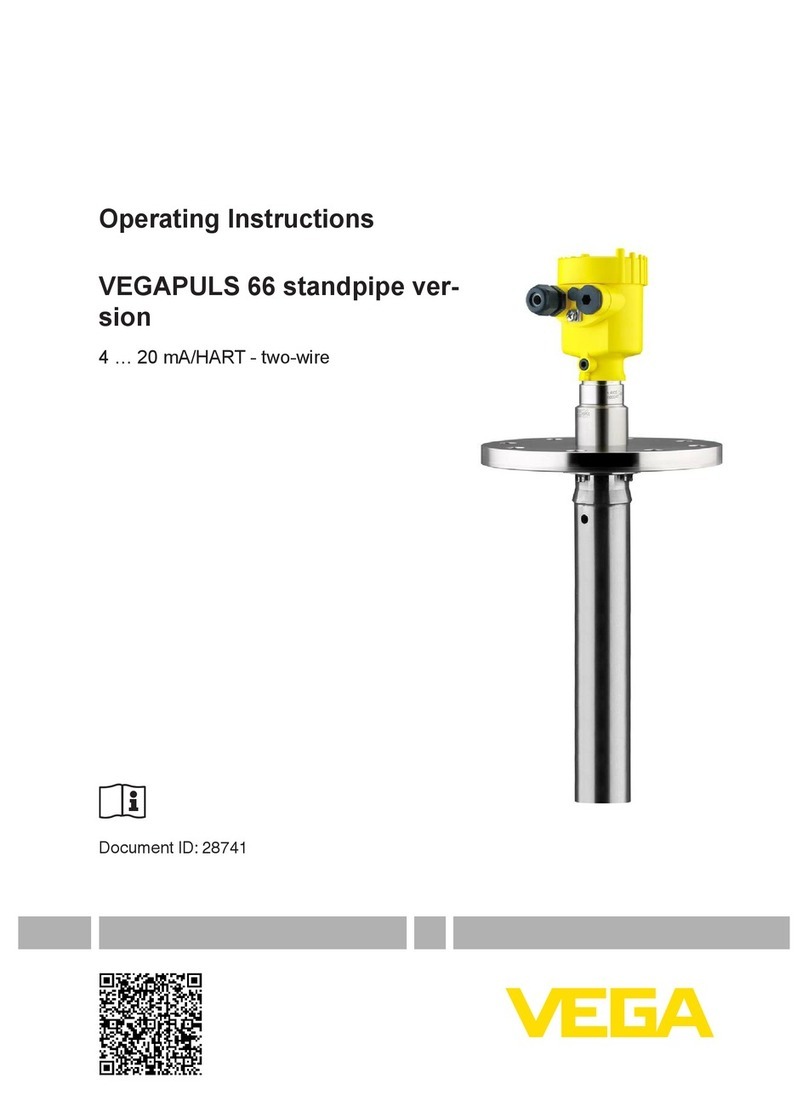Gotting HG G-19603ZA User manual

Device Description HG G-19603ZA | English, Revision 03 | Date: 31.03.2021
2Overview
Summary
Characteristics of the magnet sensor HG G-19603ZA:
•Magnet sensor for AGV guidance
•Indoor / IP 54
•Digital Magnetometer
•Technology
•For axially polarized magnet tapes,
nominal reading height 60 mm
•Interfaces
- CAN/CANopen® (data)
- USB (service & configuration)
•Three independent systems for the
detection of turnoffs, track selection via
CAN/CANopen®
•Display of operating status via 5 LEDs
© 2021 Götting KG, errors and modifications reserved.
The Götting KG in D-31275 Lehrte has
a certified quality management system
according to ISO 9001.

Device Description HG G-19603ZA | English, Revision 03 | Date: 31.03.2021
3
Table of Contents
Contents
1 About this Document........................................................................ 5
1.1 Function ................................................................................................................................... 5
1.2 Presentation of Information .............................................................................................. 5
1.2.1 Warning Notices ............................................................................................................... 5
1.2.2 Symbols ............................................................................................................................... 6
2 Introduction....................................................................................... 7
2.1 Range of Use .......................................................................................................................... 7
2.2 Qualification of the Users................................................................................................... 7
2.3 Intended Use .......................................................................................................................... 7
2.4 Functional Principle ............................................................................................................. 9
3 Mounting ......................................................................................... 11
3.1 Magnetic Tape .....................................................................................................................11
3.1.1 Magnetic Tape Types ....................................................................................................11
3.1.2 Magnetic Tape Installation ..........................................................................................12
3.2 Magnet Sensor.....................................................................................................................12
3.2.1 Requirements ..................................................................................................................12
3.2.2 Mounting on the Vehicle .............................................................................................. 13
3.2.3 Connection Cable (assembled on one side) ...........................................................14
4 Commissioning ............................................................................... 15
4.1 Configuration of the Magnet Sensor ............................................................................ 15
4.2 Compensation of Permanent Magnetic Interferences ............................................ 17
4.2.1 Compensation of Static Magnetic Interferences .................................................. 17
4.2.2 Deleting the Compensation.........................................................................................18
4.3 Automatic Calibration of the Track Detection ........................................................... 18
5 Hardware ......................................................................................... 20
5.1 LEDs ........................................................................................................................................20
5.2 Pin Assignment....................................................................................................................21
5.2.1 PWR/USB ..........................................................................................................................21
5.2.2 CAN1/CAN2......................................................................................................................22
5.3 Turning off from the Main Track .................................................................................... 22
6 Software .......................................................................................... 24
6.1 Switch-On Behavior ...........................................................................................................24
6.2 Connection to a PC via the USB Interface .................................................................. 24
6.3 Terminal Program ...............................................................................................................25
6.4 Service Program..................................................................................................................25
6.4.1 Main Menu........................................................................................................................25
6.4.1.1 Status Output ..............................................................................................................26
6.4.1.2 Status Line ...................................................................................................................26
6.4.2 (1) CSV Output ................................................................................................................27
6.4.3 (2) Settings .......................................................................................................................28
6.4.4 (C) calibration settings .................................................................................................. 29
6.4.5 (3) RAW data monitor ...................................................................................................29
6.4.6 Firmware Update ............................................................................................................30
7 CAN Bus Interface .......................................................................... 32
7.1 Receiving Box ......................................................................................................................32
7.2 Transmitter Box ...................................................................................................................33
8 CANopen® Interface ....................................................................... 34
8.1 Description of the Process Data Objects (PDOs) ...................................................... 34
8.1.1 Transmission Objects ....................................................................................................34
8.1.2 Reception Object ............................................................................................................35

Device Description HG G-19603ZA | English, Revision 03 | Date: 31.03.2021
4Table of Contents
8.2 Heartbeat ...............................................................................................................................35
8.3 Description of the Service Data Objects (SDOs) .......................................................35
8.4 Object Directory ..................................................................................................................36
8.4.1 Communication Specific Entries................................................................................36
8.4.2 Standardized Device Profile Range...........................................................................38
8.4.3 CANopen® Object Dictionary .....................................................................................38
8.4.3.1 Device Type..................................................................................................................38
8.4.3.2 Error Register...............................................................................................................38
8.4.3.3 COB-ID SYNC message ............................................................................................38
8.4.3.4 Device Name................................................................................................................38
8.4.3.5 Hardware Version.......................................................................................................39
8.4.3.6 Software Version ........................................................................................................39
8.4.3.7 Producer Heartbeat Time.........................................................................................39
8.4.3.8 Identity Object.............................................................................................................39
8.4.3.9 Receive PDO Parameter...........................................................................................39
8.4.3.10 Mapping RPDO_1.......................................................................................................40
8.4.3.11 Transmit PDO_1 Parameter ....................................................................................40
8.4.3.12 Mapping TxPDO_1 .....................................................................................................40
8.4.3.13 8 Bit Digital Input (transmitted in TxPDO 1) ......................................................41
8.4.3.14 16 Bit Analog Inputs (transmitted in TxPDO 1).................................................41
8.4.3.15 32 Bit Analog Inputs (transmitted in TxPDO 1).................................................41
8.4.3.16 8 Bit Life Counter (transmitted in TxPDO 1) ......................................................41
9 Maintenance ....................................................................................42
10 Trouble Shooting.............................................................................43
10.1 Error Codes ...........................................................................................................................43
11 Technical Data.................................................................................44
12 List of Figures..................................................................................45
13 List of Tables ...................................................................................46
14 Index ................................................................................................47
15 Copyright and Terms of Liability....................................................49
15.1 Copyright ...............................................................................................................................49
15.2 Exclusion of Liability ..........................................................................................................49
15.3 Trade Marks and Company Names ...............................................................................49

Device Description HG G-19603ZA | English, Revision 03 | Date: 31.03.2021
5
About this Document – Chapter 1
1About this Document
1.1 Function
This device description contains information regarding the correct mounting, elec-
tric installation, commissioning and maintenance of the magnet sensor HG G-
19603ZA for the technical personnel of a manufacturer who wants to integrate the
magnet sensor into an automated guided vehicle (AGV).
This device description does not contain information regarding the usage of the su-
perordinate system, e.g. the automated guided vehicle (AGV). For this information
consult the documentation of the vehicle manufacturer resp. the operator of a facil-
ity.
This device description applies to devices with firmware version V1.01 and higher
(see Figure 16 on page 25 on how to detect which firmware version your device
has).
1.2 Presentation of Information
For you to be able to use your product simply and safely this device description uses
consistent warning notices, symbols, terms and abbreviations. Those are described
in the following sections.
1.2.1 Warning Notices
In this device description warning notices appear before sequences of actions that
may lead to damage to persons or property. The listed actions for the danger preven-
tion have to be observed.
Warning notices have the following structure:
The warning symbol (warning triangle) indicates danger to life or risk of injury.
The signal word indicates the severity of the danger.
The paragraph kind or source of the danger names the kind or source of the
danger.
The paragraph consequences describes the consequences of not observing
the warning notice.
The paragraphs for danger prevention explain, how to avoid the danger.
SIGNAL WORD
Kind or source of the danger
Consequences
Danger prevention

Device Description HG G-19603ZA | English, Revision 03 | Date: 31.03.2021
6Chapter 1 – About this Document
The signal words have the following meanings:
1.2.2 Symbols
In this device description the following symbols and formatting are used:
If this information is ignored,
the product may not be operated in an optimal way.
Indicates one or more links to the Internet.
–www.goetting.de/xxx
–www.goetting.de/yyy
Indicates tips for easier
operation of the product.
The check mark lists a requirement.
The arrow shows an action step.
The indentation shows the result of an action or an action sequence.
Program texts and variables are indicated through the use of a fixed width
font.
Menu items and parameters are shown in cursive characters.
Whenever the pressing of letter keys is required for program entries, the
required etter eys are indicated as such (for any programs of Götting KG
small and capital letters are equally working).
Table 1 Hazard classification according to ANSI Z535.6-2006
Warning Symbol, Signal Word Meaning
DANGER
DANGER indicates a hazardous situation
which, if not avoided, will result in death or
serious injury.
WARNING
WARNING indicates a hazardous situation
which, if not avoided, could result in death or
serious injury.
CAUTION
CAUTION indicates a hazardous situation
which, if not avoided, could result in minor or
moderate injury.
NOTICE
NOTICE indicates property damage: The
product or the environment could be dam-
aged.

Device Description HG G-19603ZA | English, Revision 03 | Date: 31.03.2021
7
Introduction – Chapter 2
2Introduction
2.1 Range of Use
The magnet sensor is intended for indoor usage.
On the surface of the track roadway compatible magnetic tape is layed. Alterna-
tively a magnetic bar can be embedded into the roadway (see section 3.1 on
page 11).
The magnetic sensor is installed so that its underside faces the roadway and
meets the nominal reading distance towards the surface of the magnetic tape
(see section 3.2 on page 12).
2.2 Qualification of the Users
The personnel intended to operate the magnetic sensor
has been provided with this documentation.
is familiar with the functionality of the magnetic sensor.
is trained sufficiently in mounting and configuring the magnet sensor and quali-
fied to perform those tasks.
knows the risks posed by driverless vehicles and is trained in the necessary
safety precautions to assess the safe operational state of the system.
All personnel in the area of influence of the magnetic sensor is instructed regarding
the kind of the vehicle and the risks resulting from the driverless operation.
2.3 Intended Use
The magnet sensor HG G-19603ZA is intended for the track guidance of automated
guided vehicles (AGV) along magnetic tape. The sensor detects the magnetic field
above magnetic tape in vertical and horizontal direction and thus continually deter-
mines the actual deviation from the center of the track (center of the magnetic tape).
The deviation is output via the CAN/CANopen® interface.
DANGER
Missing protection equipment
The magnet sensor does not contain functionality to detect obstacles or persons
in front of a vehicle.
The vehicle manufacturer has to include suitable safety equipment.

Device Description HG G-19603ZA | English, Revision 03 | Date: 31.03.2021
8Chapter 2 – Introduction
In case the magnetic sensor is used for other purposes than specified above or is
modified all warranties against the Götting KG are null and void.
The magnet sensor is only used according to section 2.1 on page 7. The magnet sen-
sor is only mounted, configured, commissioned, operated, maintained and dis-
mounted by personnel according to section 2.2 on page 7.
DANGER
The vehicle leaving the track
Interferences as specified in section 3.2 on page 12 may lead to inaccurate
outputs whereby the vehicle may leave the track.
The vehicle manufacturer has to include functionality to detect this and stop
the vehicle if needed
As an aid the status of the track detection in the CAN/CANopen® telegrams can
be used, see chapter 7 „CAN Bus Interface“ on page 32 / 8 „CANopen®
Interface“ on page 34.
Also a failure of the CAN/CANopen® communication must be detected as
leaving the track.

Device Description HG G-19603ZA | English, Revision 03 | Date: 31.03.2021
9
Introduction – Chapter 2
2.4 Functional Principle
The sensor is based on digital magnetometer technology for the detection of the
magnetic field above the magnetic tape.
Figure 1 Detection of the magnetic field
The sensor has three independent detection systems. Via two digital inputs one of
two tracks can be chosen dynamically. Thus the sensor can detect junctions and fol-
low turnoffs (also see 5.3 on page 22).
Figure 2 Three detection systems for the recognition of junctions
The operating state is shown via the LEDs described in section 5.1 on page 20.
The current deviation from the center of the selected track and the current level of
the magnetic field are output via the CAN/CANopen® interface. Additionally a detect
signal is generated when a magnetic tape is detected underneath the sensor.
N
N
Magnetic tape
roadway
roadway
Magnet sensor
element
Lines of identical flux
density above the
magnetic tape
Magnet sensor
element
Magnetic tape
Direction
of travel
B
Z
B
X
B
ZY
Z
Z
X
+X
+X
-X
-X
B=max
Z
S
S
S
S
B=0
X
B >0
X
Deviation to the
right side.
B =0
X
No deviation.
The magnet sensor is
positioned centrical
above the magnetic
tape.
1
1
B = Flux density
1
1
2
2
3
3
Magnet sensor with three
Magnetic tape
track with junction
detection systems for the recognition
of junctions
(there may only ever be max. two
tracks simultaneously underneath the
magnet sensor)

Device Description HG G-19603ZA | English, Revision 03 | Date: 31.03.2021
10 Chapter 2 – Introduction
The detection range depends on the mounting height of the sensor and the type of
the magnetic tape. As shown in Figure 1 above the sensor detects the deviation X
from the center of the track by measuring the horizontal magnetic flux density. The
higher the deviation the higher the output level.
Figure 3 shows the signals output vi the CAN/CANopen® interface when moving the
sensor in X direction above the magnetic tape (crosswise to the direction of travel).
Figure 3 Signal paths of the outputs (idealized diagram)
Figure 4 Dependence of the output on the height above the magnetic tape
‐10
10
‐80 ‐75 ‐70 ‐65 ‐60 ‐55 ‐50 ‐45 ‐40 ‐35 ‐30 ‐25 ‐20 ‐15 ‐10 ‐5 0 5 10 15 20 25 30 35 40 45 50 55 60 65 70 75 80
OUT
PUT_X
OUT
PUT_Z
Detect
Detect = 1
Signal path
Deviation of the
sensor from the
center of the
magnetic tape
[mm]
0
‐15
‐10
‐5
0
5
10
15
‐100
‐95
‐90
‐85
‐80
‐75
‐70
‐65
‐60
‐55
‐50
‐45
‐40
‐35
‐30
‐25
‐20
‐15
‐10
‐5
0
5
10
15
20
25
30
35
40
45
50
55
60
65
70
75
80
85
90
95
100
Height 30mm
Position of the track [mm]
Output_X
Height 40mm
Height 50mm
Height 60mm
Height 70mm

Device Description HG G-19603ZA | English, Revision 03 | Date: 31.03.2021
11
Mounting – Chapter 3
3Mounting
3.1 Magnetic Tape
For the operation of the magnet sensor HG G-19603ZA axially polarized magnetic
band is to be used. The direction of the polarization can be configured s. Figure 20
on page 28). The polarization has to be identical for a whole facility.
Figure 5 Supported and unsupported magnetization of the magnetic tape
3.1.1 Magnetic Tape Types
Götting offers suitable magnetic tapes. Magnetic tape is sticked to the ground. Alter-
natively embedded magnetic bar can be used that is layed in a groove cut into the
ground. Götting magnetic tapes always have the north pole on the top. The following
elements are available:
Table 2 Order numbers magnetic tape
Order no. Description Notes
HW MAT00003 Magnetic tape, self-adhesive, on a roll
W x H 50 x approx. 1,2 mm
Roll, length 15.2 m
HW MAT00004 Embedded magnetic bar,
W X H 6 x 10 mm
quote length
HW MAT00005 Magnetic tape, self-adhesive curve seg-
ment
30o segment of circle, radius 600 mm
Curve segments
HW MAT00006 Magnetic tape, self-adhesive curve seg-
ment
30o segment of circle, radius 800 mm
HW MAT00007 Magnetic tape, self-adhesive curve seg-
ment
30o segment of circle, radius 1,000 mm
HW MAT00008 Magnetic junction, branch to the right,
self-adhesive, radius 1,000 mm
Junction segments
HW MAT00009 Magnetic junction, branch to the left, self-
adhesive, radius 1,000 mm
(default) (configurable)
multipolar magnetization
axial magnetization axial magnetization
not OK

Device Description HG G-19603ZA | English, Revision 03 | Date: 31.03.2021
12 Chapter 3 – Mounting
3.1.2 Magnetic Tape Installation
The installation of both the magnetic tape and the embedded magnetic bar is spec-
ified in a separately available document that you can download at the following ad-
dress:
http://goetting-agv.com/components/19600
3.2 Magnet Sensor
3.2.1 Requirements
External magnetic fields with a field strength below the Earth‘s magnetic field do not
influence the magnet sensor. For stronger fields the strength and position of the field
determine whether the magnet sensor is affected or can even be configured to com-
pensate the influence. Fields that asymmetrically influence from a certain direction
(left or right) or only occur at certain points of the course are harder to compensate.
Generally interferences should be minimized so that the magnet sensor can detect
the track reliably. Therefore:
Figure 6 Areas around sensor and tape that need to be free of ferromagnetic materials
An area of 100 mm around the sensor should be free of ferromagnetic materi-
als. Those divert the magnetic field and distort the readings. Similarly an area
with a diameter of approximately the nominal reading height around the mag-
netic tape should be free of ferromagnetic materials.
DANGER
False output due to interfering signals
Additional magnetic fields close to the magnet sensor can affect the system
characteristics. This may lead to the vehicle leaving the track.
The vehicle manufacturer has to include functionality to detect this and stop
the vehicle if needed
As an aid the status of the track detection in the CAN/CANopen® telegrams can
be used, see chapter 7 on page 32 / 8 on page 34.
Also a failure of the CAN/CANopen® communication must be detected as
leaving the track.
100
100
100
356
100
100
Front view
Vehicle body
Roadway Magnet
tape
Magnet
sensor
Side view
‚metal-free‘
areas around
sensor and magnet
tape without
ferromagnetic
materials
Roadway
Magnet
sensor
Nominal
reading dist.
Nominal
reading distance
optional
distance
Vehicle
body
piece
(example)

Device Description HG G-19603ZA | English, Revision 03 | Date: 31.03.2021
13
Mounting – Chapter 3
Around the sensor and the magnetic tape there may be no additional magnetic
fields (permanent magnets, electromagnets, electrical wires, etc.). How much
the readings are disturbed by interferences depends on the field strength.
Electric motors have to be sufficiently shielded.
Interferences from the vehicle occur permanently, interferences along the track tem-
porarily. Permanent interferences can sometimes be compensated with offsets (see
6.4.3 on page 28). Constant magnetic interferences (e. g. brakes that are released
electromagnetically) can be compensated, see section 4.2 on page 17.
Interferences along the track have to be avoided e.g. by moving the magnetic track
or by shielding the source.
3.2.2 Mounting on the Vehicle
Figure 7 Casing dimensions and mounting drill holes of the magnet sensor
The magnet sensor has two drill holes with a diameter of 5 mm each with which it
can be mounted by putting screws through the holes. We recommend the usage
of non-magnetizable VA screws. The drill holes have a distance of 140 mm to
each other (center of hole <—> center of hole). The magnet sensor is to be mounted
diagonally to the direction of travel with the connectors facing upwards (first sketch
in Figure 7 above). The recommended reading height is 60 mm from the bottom
edge of the casing to the magnetic tape.
Around the sensor there has to be an area free of ferromagnetic materials. Thus the
sensor usually can‘t be mounted directly onto the body of the vehicle. We recom-
mend using a mounting bracket or mounting plate, e.g. made from Aluminium or
acrylic glass (e.g. Plexiglas®), see Figure 8 below.
69 5 mm.
16 mm
31 mm
53 mm.
53 mm
156 5 mm.
140 m m
1
2
3
4
5
2
1
4
3
5
PWR/USB
Drill holes for mounting screws (screws not within the scope of supply)
Direction
of travel
Bottom edge
of the casing
M12 x 1 circular connector
5-pin male
M12 x 1 circular connector
5-pin female
CAN1 CAN2

Device Description HG G-19603ZA | English, Revision 03 | Date: 31.03.2021
14 Chapter 3 – Mounting
Figure 8 Possible mounting pos. for the magnet sensor when using an optional distance piece
If the magnet sensor has to be mounted side-inverted (aka backwards) the output
voltages for the left and right deviations may be interchanged compared to what the
vehicle control expects. In this case the output voltage AOUT1 can be inverted inside
the sensor, see 6.4.3 on page 28.
3.2.3 Connection Cable (assembled on one side)
Connect the sensor to the vehicle control. For this the connectors ST 1 and ST 2 are
used. The assignment of the pins is shown in section 5.2 on page 21. The following
optional cable extensions can be used.
Table 3 Accessories / cable extensions
Order no. Description
HW CAB00001 PWR/USB: Cable PUR, 5m with one M12 angle coupling, 5
pin, A coded, one end open
HW CON00055 CAN1: CAN terminator
Plug M12 5 pin, A coded
HW CON00100 CAN1: Closing plug M12
5 pin, A coded, shieldable
HW CAB00064 CAN2: CAN Bus cable,
10 m, with shielding, one-sided M12 socket straight
Magnet tape
Roadway
Optional
Magnet sensor
Vehicle body
Direction of travel
distance piece
(material non
ferro-magnetic)

Device Description HG G-19603ZA | English, Revision 03 | Date: 31.03.2021
15
Commissioning – Chapter 4
4Commissioning
The sensor is pre-configured to detect a single track without turnoffs. If the
default settings of the CAN interface are compatible with the application it may be
sufficient to install the sensor and connect it to the vehicle control. However we rec-
ommend to always connect it to a PC and configure it as shown below to minimize
interferences. If more than one track is to be detected and if there are turnoffs in the
driving course then the configuration as shown below has to be performed.
For the commissioning configuration the USB interface in connector ST 1 is used.
Connect ST 1 to a PC as shown in section 6.2 on page 24. Then start a compatible
terminal program with ANSI emulation (see section 6.3 on page 25). Then you can
use the service program that runs inside the magnet sensor (section 6.4 on page 25).
For the following explanations we assume that your sensor is running with its de-
fault configuration. If needed the default settings can be restored in the settings
menu, see section 6.4.3 on page 28.
4.1 Configuration of the Magnet Sensor
The goal of the configuration is the reliable recognition of magnetic tracks.
For this the thresholds for the detection of one (resp. two) tracks have to be adjusted.
The detection of two tracks is necessary if there are to be junctions in the track. A
track is detected when the magnetic flux density is above the set threshold. The
track detection has an internal switching delay of 2 % so that it does not react too
sensitively in border areas. For the commissioning the following menus and sub-
items of the service program are used:
Figure 9 Commissioning: Menus of the service program
HG 19603 Serialnumber: 123456 Firmwareversion: V1.01
system monitor
__ __
| | | |
---------------------------------
| HG 19603 O O G O G |
| |
---------------------------------
next turn: STRAIGHT
position track: 0.00
(L) left
error: 0x00 (R) right
(S) straight
(D) CAN input
(1) CSV Output
(2) settings
(3) raw data
CAN Status: Rx: 160 Tx: 185 OutX: 0.00 OutZ: 0.00 Out: 0x00 In: 0x00
HG 19603 Serialnumber: 123456 Firmwareversion: V1.01
settings
Range:
(1) track polarity : north
(2) sensitivity : 0.200 [mT] 0.01 .. 2
(3) sen. two tracks: 0.800 0.1 .. 4
(4) CAN Mode : CAN
(5) CAN Baudrate : 1000 KBit/s
(6) CAN ID Tx : 0x03F / 0063d 0x000 .. 0x7FF
(7) CAN ID Rx : 0x040 / 0064d 0x000 .. 0x7FF
(8) datarate : 10 [ms] 1 .. 100
(C) calibration
(D) load default settings
(S) save settings
(F) firmware update
(ESC) QUIT
HG 19603 Serialnumber: 123456 Firmwareversion: V1.01
RAW data monitor
__ __
| | | |
---------------------------------
| HG 19603 O O O O O |
| |
---------------------------------
system 3 system 2 system 1
X 0.029810 [mT] 0.038477 [mT] 0.033569 [mT]
Y 0.023682 [mT] 0.049927 [mT] 0.036011 [mT]
Z -0.003369 [mT] -0.033130 [mT] 0.006274 [mT]
track No No No
detect
sum of flux density: 0.160
(ESC) QUIT
Key 2 Key 3
Back with ESCBack with ESC
Main menu

Device Description HG G-19603ZA | English, Revision 03 | Date: 31.03.2021
16 Chapter 4 – Commissioning
Meaning of the highlighted parameters:
track polarity in settings menu: Polarity of the magnetic tape
sensitivity in settings menu: Sensitivity of the detection of a magnetic track,
threshold value in milliTesla (mT)
sen. two tracks in settings menu: Sensitivity of the detection of two magnetic
tracks. For applications without junctions set to maximum value 4.
CAN ... in settings menu: If the default settings of the CAN bus do not match
your required settings adjust them here.
sum of flux density in raw data menu: Flux density of a magnetic tape under-
neath the sensor
When using one of the magnetic tapes listed in section 3.1.1 on page 11
(HW MAT00003, HW MAT00008 and HW MAT00009) the threshold sen. two tracks
for two magnetic tracks can be set according to the following table:
If there are problems detecting the track or when the working conditions are differ-
ent we recommend the following configuration sequence:
Configure the polarity of the magnetic tape (track polarity in settings menu).
Default for Götting magnetic tape or embedded magnetic bar: North.
Place the sensor centered above a piece of the used magnetic tape (default
reading height 60 mm). The piece should be long enough so that at least 10 cm
protrude behind and in front of the sensor.
Switch to the menu raw data and write the shown sum of flux density down.
Then switch to the settings menu and configure the sensitivity to be approx. one
fifth of the sum of flux density.
Switch to the main menu and move the sensor diagonally to the magnetic tape.
Check that the track is reliably detected even when it reaches the lateral edges
of the magnet sensor. Optionally the sensitivity in the settings menu has to be
reduced if the track is not detected in the border areas.
If the turnoff function is to be used the threshold sen. two tracks has to be
configured. Table 4 above shows typical values when Götting magnetic tape is
used. Typically the threshold for the detection of two tracks is about three times
the value for one track. If the turnoff function is not needed (because there are
no junctions in the track) sen. two tracks should be set to its maximum value of
4. A good starting point for the threshold for detection of two tracks is three
times the limit for one track.
In order to test the threshold for two tracks place two pieces of magnetic tape
underneath the sensor so that the left edge of the left tape should be directly
underneath the left edge of the sensor, the right edge of the right tape should
match the right edge of the sensor. If one of the two tracks is now selected, two
magnetic tapes should be reliably detected. The track is selected via the CAN/
CANopen® interface (see chapter 7 on page 32 / 8 on page 34) or for testing via
the manual control in the main menu, see Figure 16 on page 25.
Table 4 Thresholds for two magnetic tracks with standard magnetic tapes
Reading height [mm] 50 60 70 80 90 100
sen. two tracks [mT] 0.8 0.64 0.5 0.4 0.32 0.275

Device Description HG G-19603ZA | English, Revision 03 | Date: 31.03.2021
17
Commissioning – Chapter 4
4.2 Compensation of Permanent Magnetic Interferences
4.2.1 Compensation of Static Magnetic Interferences
Figure 10 Commissioning: Compensation of static magnetic interferences
NOTICE
Only static interferences can be compensated
The source of the interferences has to move together with the magnet sensor
and its strength may not change.
NOTICE
There is currently no possibility to enable or disable the compensation during
operation! If there is e.g. an electromagnetic brake that emits interferences when
activated but emits no interferences when it is inactive this can not be
dynamically compensated. If a permanent compensation would be set for the
possible interferences the output of the magnet sensor would be off by the
scope of the compensation whenever the brake is inactive.
The compensation is only usable for permanent interferences.
NOTICE
The compensation of interferences limits the range of the magnetic field that can
be used for the track detection.
The magnetic field and the compensated interferences together have to fit
inside the maximum detection range of the magnet sensor.
HG 19603 Serialnumber: 123456 Firmwareversion: V0.01
calibration settings
compensated magnetic field:
system 3 system 2 system 1
0.001 [mT] -0.021 [mT] -0.059 [mT]
-0.046 [mT] -0.054 [mT] -0.044 [mT]
0.013 [mT] 0.019 [mT] 0.022 [mT]
(1) calibrate for track detection
(2) calibrate for static magnetic field
(3) delete static magnetic field compensation
(ESC) QUIT
HG 19603 Serialnumber: 123456 Firmwareversion: V0.01
calibration settings
compensated magnetic field:
system 3 system 2 system 1
0.000 [mT] 0.000 [mT] 0.000 [mT]
0.000 [mT] 0.000 [mT] 0.000 [mT]
0.000 [mT] 0.000 [mT] 0.000 [mT]
(1) calibrate for track detection
(2) calibrate for static magnetic field
(3) delete static magnetic field compensation
(ESC) QUIT
HG 19603 Serialnumber: 123456 Firmwareversion: V0.01
calibration settings
compensated magnetic field:
system 3 system 2 system 1
0.000 [mT] 0.000 [mT] 0.000 [mT]
0.000 [mT] 0.000 [mT] 0.000 [mT]
0.000 [mT] 0.000 [mT] 0.000 [mT]
reading earth magnetic field...
please TURN OFF static field
please REMOVE all track form the sensor
(1) continue
(ESC) abourt
(ESC) QUIT
HG 19603 Serialnumber: 123456 Firmwareversion: V0.01
calibration settings
compensated magnetic field:
system 3 system 2 system 1
0.000 [mT] 0.000 [mT] 0.000 [mT]
0.000 [mT] 0.000 [mT] 0.000 [mT]
0.000 [mT] 0.000 [mT] 0.000 [mT]
reading static magnetic field...
please TURN ON static filed
please REMOVE all track form the sensor
(1) continue
(ESC) abourt
(ESC) QUIT
Key 2 Key 1
Key 1
Example values

Device Description HG G-19603ZA | English, Revision 03 | Date: 31.03.2021
18 Chapter 4 – Commissioning
Take the following steps:
Mount the magnet sensor at the desired mounting position on the AGV.
In menu Settings choose the option Calibration.
Use menu entry calibrate for static magnetic field.
Deactivate the interferences.
Confirm with continue. the sensor measures the magnetic field in its
surroundings.
Turn the interferences on. Don‘t move the sensor/vehicle while doing so.
Confirm with continue. The sensor measures the magnetic field in its
surroundings and calculates the amount of the interferences.
The calculated interferences are shown in the menu and will be subtracted
from the sensor‘s raw data.
4.2.2 Deleting the Compensation
In menu Settings choose the option Calibration.
Use menu entry delete static magnetic field compensation.
The parameters for the static compensation are deleted and no longer used.
4.3 Automatic Calibration of the Track Detection
In order to make it easier to set the thresholds it is possible to use the automatic con-
figuration. In order to do so place the magnet sensor centered above the magnetic
track, then start the calibration (see below). It is still possible to manually set the pa-
rameters or to change the parameters found during the automatic calibration.
If static interferences are compensated (see above) the interferences have to be
present during the automatic calibration since they are subtracted from the mea-
sured field.
Figure 11 Commissioning: Automatic calibration
HG 19603 Serialnumber: 123456 Firmwareversion: V1.01
calibration settings
compensated magnetic field:
system 3 system 2 system 1
0.000 [mT] 0.000 [mT] 0.000 [mT]
0.000 [mT] 0.000 [mT] 0.000 [mT]
0.000 [mT] 0.000 [mT] 0.000 [mT]
(1) calibrate for track detection
(2) calibrate for static magnetic field
(3) delete static magnetic field compensation
(ESC) QUIT
HG 19603 Serialnumber: 123456 Firmwareversion: V1.01
calibration settings
compensated magnetic field:
system 3 system 2 system 1
0.000 [mT] 0.000 [mT] 0.000 [mT]
0.000 [mT] 0.000 [mT] 0.000 [mT]
0.000 [mT] 0.000 [mT] 0.000 [mT]
reading magnetic track...
please TURN ON static field if static field is compansated
please PLACE one track under the center of the sensor
(1) continue
(ESC) abourt
Key 1
Key 1, to
perform
calibration

Device Description HG G-19603ZA | English, Revision 03 | Date: 31.03.2021
19
Commissioning – Chapter 4
Take the following steps:
Place the magnet sensor in the desired height centered above a single
magnetic track.
In menu Settings choose the option Calibration.
Use menu entry calibrate for track detection.
If the compensation from section 4.2 on page 17 is in use make sure that the
interferences are present.
Confirm with continue that the sensor is placed centered above a single
track.
The following parameters are automatically configured: sensitivity, sen. two
tracks.

Device Description HG G-19603ZA | English, Revision 03 | Date: 31.03.2021
20 Chapter 5 – Hardware
5Hardware
5.1 LEDs
There are 5 LEDs to control the sensor‘s function.
Figure 12 Positions of the LEDs
Table 5 Meaning of the LEDs
LED Color Meaning
PWR green blinks for normal operation
ERR red lights up on internal error, s. Table 38 on page 43
TRACK green lights up when a track is detected
CLIP red lights up when the magnetic field is overloaded
USB green –lights up when USB connection is established
–blinks for active communication via the USB
interface
CAN Tx green blinks when sending CAN messages
CAN Rx green blinks when receiving CAN messages
This manual suits for next models
1
Table of contents
Other Gotting Accessories manuals
Popular Accessories manuals by other brands
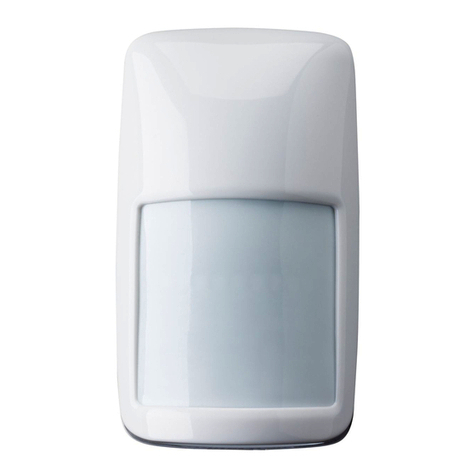
Honeywell
Honeywell V-Plex DT8050A-SN Quick installation guide
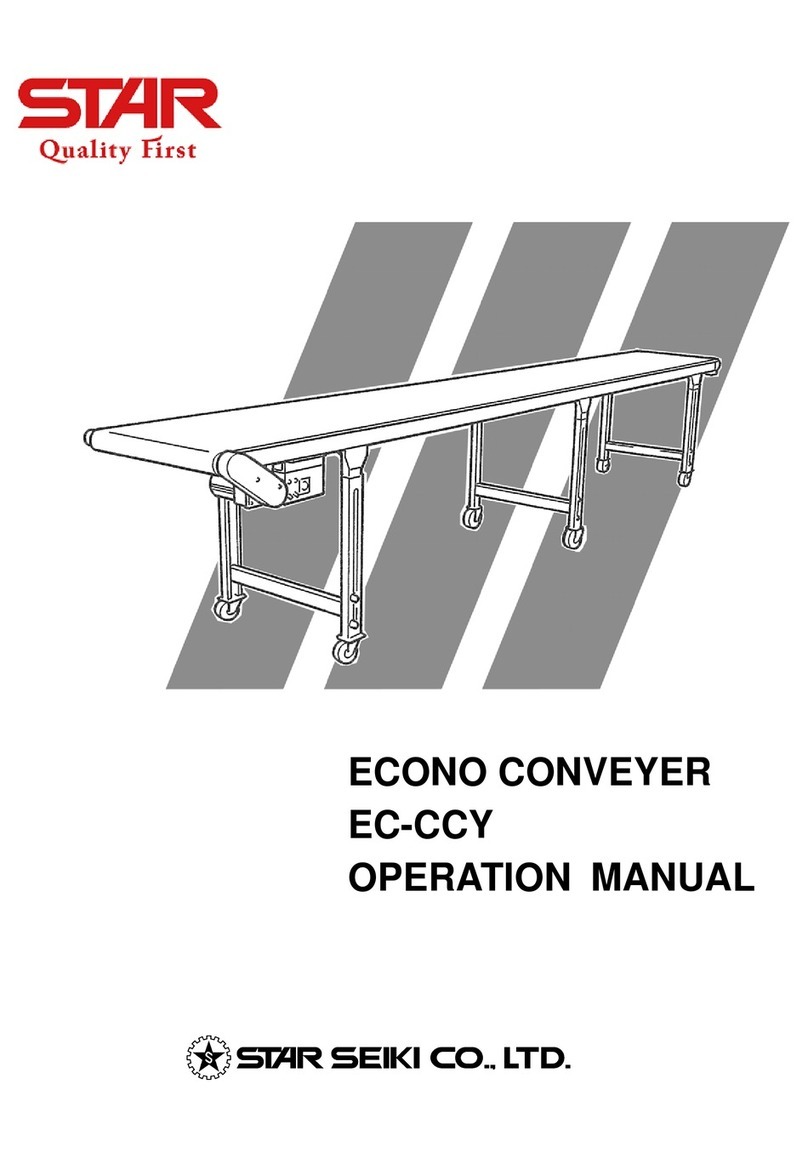
Star
Star ECONO EC-CCY Operation manual
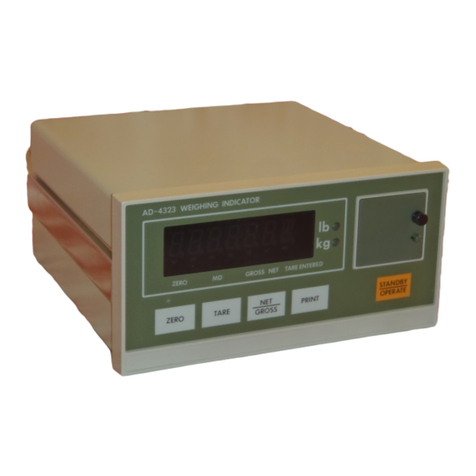
A&D
A&D AD-4323 instruction manual
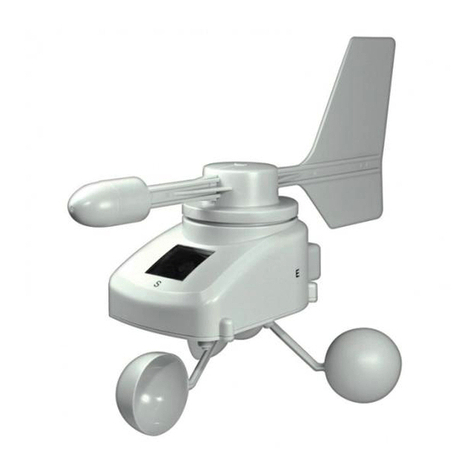
La Crosse Technology
La Crosse Technology TX-63U-IT instruction manual
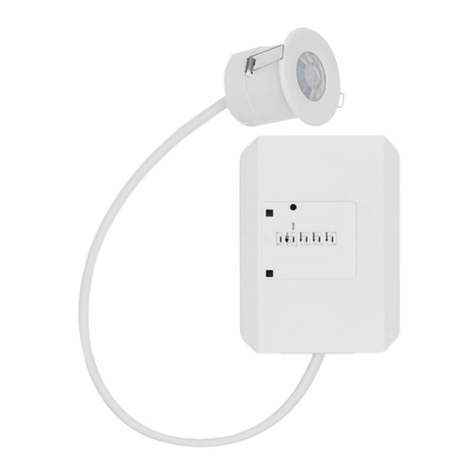
Vadsbo
Vadsbo Sensor Narrow installation manual
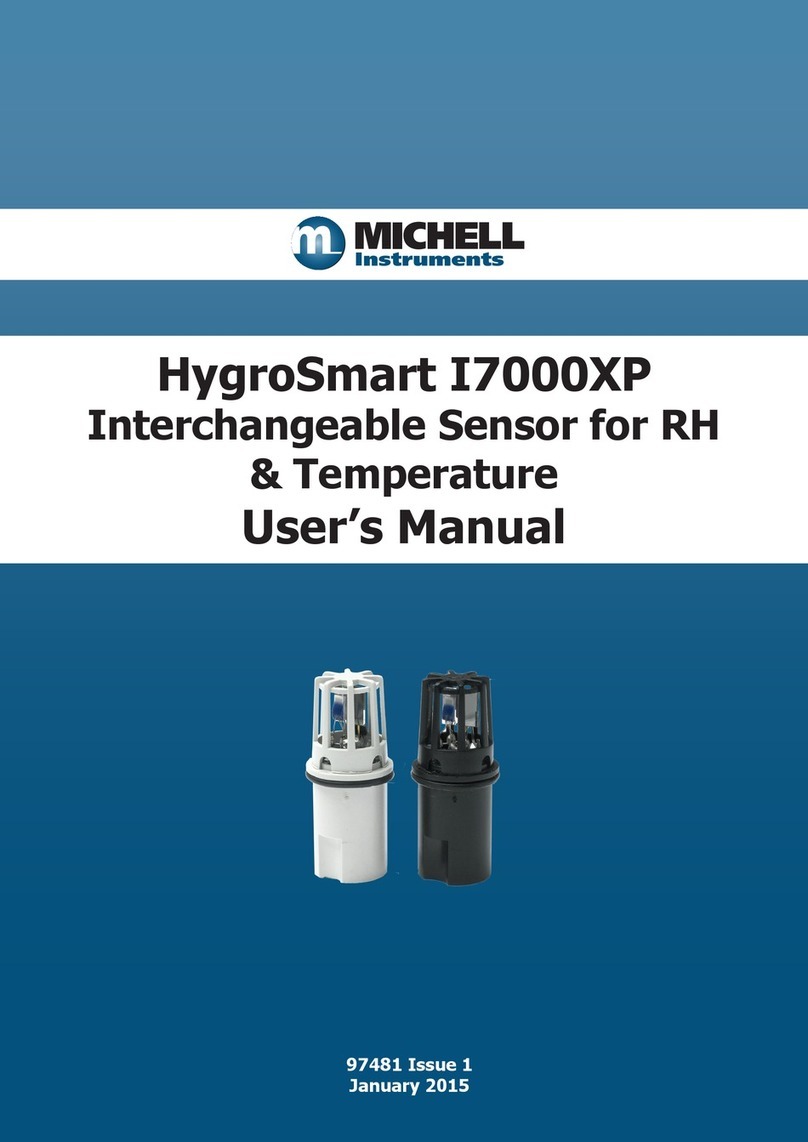
Michell Instruments
Michell Instruments HygroSmart I7000XP user manual

